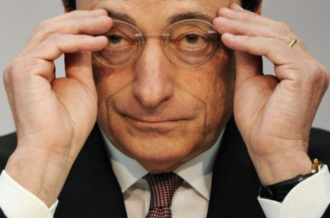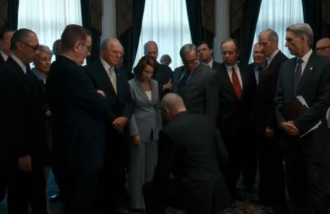The image of one of the “Masters of the Universe”, the former boss of Goldman Sachs, Hank Paulson, getting down on one knee to beg Democrat Nancy Pelosi, to approve TARP, is one of the most memorable of this crisis. And yet it was not photographed, even if it was widely reported by a highly entertained press (particularly the fact he was in a $3500 suit). That was some four and a half years ago in September 2008.
The $700 billion Troubled Asset Relief Program enabled the US Treasury to inject capital into the financial system. The aim was to stabilise the financial sector and avoid a highly damaging credit crunch. At the time, it was widely criticised by the American public and caused rage in the media. “Main Street Bailing out Wall Street”.

And yet it has done exactly what is supposed to do. The American economy is growing, the financial industry is healthy and the property market rebounding. The giant bailout package was created to avoid a repeat of the great 1930’s depression and it did.
Compare that to Europe where the banking industry is still in a tragic mess. Europe needs to follow the example of the USA and create a TARP. But for TARP it needs a Hank – someone to make it happen. And I can’t see anyone willing to take on that role.
The problem is that there is political abhorrence of using taxpayer’s money to bail out what many view as irresponsible, greedy and sometimes corrupt, bankers. And yet the American experience shows it is the right thing to do. TARP has been hugely beneficial for the US economy as it has enabled its financial system to recover and lend again.
And it has been a good investment for taxpayers too. At the latest Treasury Report to Congress in March, “taxpayers have recovered $393 billion – or 94 percent – of the $419 billion in TARP funds disbursed to date”. So almost all the money has been paid back already. The US government has got all of its $269bn back from programmes specifically for banks plus a $24bn profit! No Surprise then that the Treasury states “By any objective standards, the Troubled Asset Relief Program has worked: it helped stop widespread financial panic, it helped prevent what could have been a devastating collapse of our financial system, and it did so at a cost that is far less than what most people expected at the time the law was passed”.
But there is absolutely no political desire in Europe to replicate TARP. Politicians do not want to risk the public’s animosity and therefore their chances of re-election by using taxpayer’s cash to help the banking industry that is blamed for so much of this crisis. And yet, such bold and brave action is desperately needed.
At the press conference on April 4, ECB President Mario Draghi frequently mentioned the weak European banking industry and the negative impact on GDP.

Mario Draghi at the April 4 ECB press conference
In particular Draghi noted that European banks had withdrawn credit from mid-2011 (at the height of EZ concerns) which he believed had been a significant contributor to the subsequent slump in economic output. He talks about the “tight credit conditions (which) will continue to weigh on economic activity” and “particularly for small and medium sized enterprises in several euro area countries”.
Draghi understands that the European banking industry needs to be strengthened.
“It is very urgent that we have a European framework for the resolution, recapitalisation and restructuring of the banking industry,” Draghi said.
He adds “it is essential…. The resilience of banks (is) strengthened where needed” and of the importance of “proceed(ing) with financial sector restructuring”. But the problem is although the ECB has propped up Europe’s banks temporarily thanks to the LTRO and more obliquely, the OMT, the ECB “cannot replace the lack of capital in the banking industry.” This is a job for the political class who know voters hate bankers. Witness the new highly popular EU banker’s bonus cap.
To be fair, the EU is slowly creating structures to help its troubled banks – the European Stability Mechanism and the promised Banking Union. However neither is close to the power and impact of TARP.
Firstly, the ESM comes with strings attached. For a government to seek cash for its banking industry through the ESM, it has to agree to budgetary oversight from Brussels. Few politicians are willing to do this and prefer to pretend that the banking system is not quite as bad as it truly is. Spanish banks finally took around €40 billion at the end of last year but this was much delayed.
The aim of a banking union is that when a banking industry is failing, it should not drag an entire country down with it, as occurred in Ireland. However there is still a very long way to go politically in creating it. And Cyprus showed us quite how far – no single regulator, no agreed approach to wind the failed banks down, no common deposit insurance and no mutualisation of the losses. And this is the main political problem – the sharing of bank losses across Europe. This is still a highly contentious subject. Draghi restated his position against mutualising bank debt last week, although without it, I cannot see how the link between banks and sovereigns gets broken.
The ESM and the Banking Union do offer hope for the future. But in the meantime, a credit and confidence crunch is seriously damaging Europe’s economy. And it is a feedback loop: worse GDP, banks take losses and so don’t lend, which leads to a credit crunch and back to worse GDP etc.
The eurozone needs a Hank, who was willing to be hated by almost all, to save his country. It needs someone to plead with politicians that taxpayer’s money must be injected into the financial system to help the wider economy (and therefore all those taxpayers).

A reenactment of Paulson begging Pelosi from Too Big to Fail
The next question is, who could be Eurozone Hank?
And this is the problem. We have no one with the authority or desire to stand up and demand that eurozone’s banks need more capital and help with their bad loans. Draghi tries to send the message out but is reluctant to go further given the separation of central banks and government.
TARP was signed into in October 2008 – a swift and bold response to the crisis from Washington. And yet in Europe, years have gone by as the slow political process to create the “institutions” required, plays catch-up. Now this may be democratically ideal and the Merkel solution, but time is damaging. Zombie banks continue to live the life of the undead and throttle Europe’s economic output. Weaker GDP increases government debt – another feedback loop as the state’s banks tend to own the debt of their sovereign.
Bold action is required. The Eurozone needs a TARP (and a Hank) and its Stress Tests? Just remember Laiki Bank and the Bank of Cyprus passed those less than a year ago.
When I first proposed this column to Adam, he quipped that “with 17 countries in the euro, the EZ’s Paulson will have to get on his knees a lot of times” which is – both witty and succinctly summaries the problem.
And just to remind you of Just to remind you of Ms Pelosi’s great retort to Hank on his knees? “I didn’t know you were a Catholic”. Brilliant!


